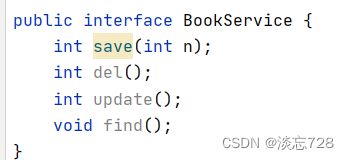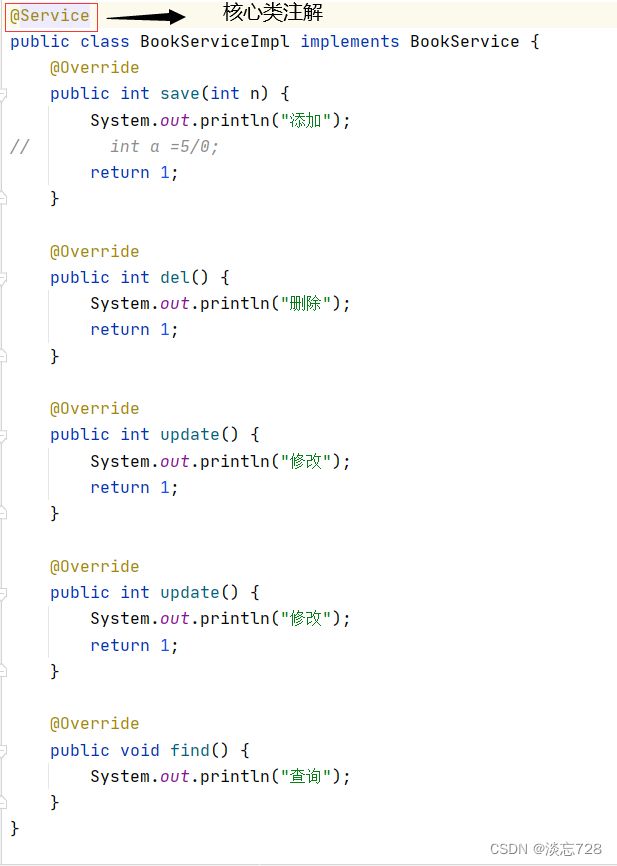Spring中的AOP
1.概述
在软件业,AOP为Aspect Oriented Programming的缩写,意为:面向切面编程,通过预编译方式和运行期间动态代理实现程序功能的统一维护的一种技术。AOP是OOP的延续,是软件开发中的一个热点,也是Spring框架中的一个重要内容,是函数式编程的一种衍生范型。利用AOP可以对业务逻辑的各个部分进行隔离,从而使得业务逻辑各部分之间的耦合度降低,提高程序的可重用性,同时提高了开发的效率。AOP(面向切面编程)_百度百科
2.相关术语
Joinpoint(连接点):
所谓连接点是指那些被拦截到的点。在 spring 中,这些点指的是方法,因为 spring 只支持方法类型的连接点。
Pointcut(切入点):
所谓切入点是指我们要对哪些 Joinpoint 进行拦截的定义。
Advice(通知/增强):
所谓通知是指拦截到 Joinpoint 之后所要做的事情就是通知。通知的类型:前置通知,后置通知,异常通知,最终通知,环绕通知。
Introduction(引介):
引介是一种特殊的通知在不修改类代码的前提下, Introduction 可以在运行期为类动态地添加一些方法或 Field。
Target(目标对象):
代理的目标对象。
Weaving(织入):
是指把增强应用到目标对象来创建新的代理对象的过程。spring 采用动态代理织入,而 AspectJ 采用编译期织入和类装载期织入。
一个连接点可以同时匹配多个切点,而切点所对应的增强在连接点上织入顺序的规则是这样的:
如果在同一个切面类中声明的增强,则按照增强在切面类中定义的顺序进行织入;
如果增强位于不同的切面类中,并且这些切面类都实现了org.springframework.core.Ordered接口,则由 Ordered 方法的顺序号决定(顺序号小的先织入);
如果增强位于不同的切面类中,但这些切面类没有实现org.springframework.core.Ordered 接口,织入的顺序是不确定的。
Proxy(代理):
一个类被 AOP 织入增强后,就产生一个结果代理类。
Aspect(切面):
是切入点和通知(引介)的结合。
Advisor
这个概念是从 Spring 1.2的 AOP 支持中提出的,一个 Advisor 相当于一个小型的切面,不同的是它只有一个通知(Advice),Advisor 在事务管理里面会经常遇到。
3.代码示例
1、创建项目并导入jar包
2、接口与核心类;
public interface BookService {
int save(int n);
int del();
int update();
void find();
}创建BookServiceImpl类,完成核心功能操作;
/**
* 核心类
*/
public class BookServiceImpl implements BookService {
@Override
public int save(int n) {
System.out.println("添加");
return 1;
}
@Override
public int del() {
System.out.println("删除");
return 1;
}
@Override
public int update() {
System.out.println("修改");
return 1;
}
@Override
public void find() {
System.out.println("查询");
}
}3、创建Logger类,用来做功能的增强类;
/**
* 增强类
*/
public class Loger {
public void check(){
System.out.println("前置通知/增强:执行系统的权限验证");
}
public void logPrint(){
System.out.println("后置通知/增强:执行日志的打印");
}
public void exception(){
System.out.println("异常通知/增强:做出异常的处理");
}
public void destroy(){
System.out.println("最终通知/增强:资源的释放");
}
}4、在的spring.xml中开始进行AOP的配置;
4.1、首先把核心类和增强类的bean配置到IOC的容器中
4.2、使用
5、测试类测试BookServiceImpl的方法是否被增强;
public class Test01 {
@Test
public void test01(){
ClassPathXmlApplicationContext context = new ClassPathXmlApplicationContext("spring.xml");
BookService bookService = context.getBean(BookService.class);
bookService.save(5);
}
}日志信息
4.环绕通知
环绕通知是一种提供自由灵活对核心类方法进行增强的操作手段,首先还是在spring.xml中配置环绕通知。包含了前置、后置、异常、最终通知;
通过ProceedingJoinPoint的实现类对象(spring框架会创建)获取要增强的那个类的方法参数、执行方法、获得方法返回值。然后在方法执行之前的操作就是前置通知、在方法执行后的操作就是后置通知、在异常处理中的操作就是异常通知、在finally中执行的操作就是最终通知。
1、配置环绕通知
2、在增强类中完善环绕通知的方法,定义一个ProceedingJoinPoint接口对象作为方法参数,且方法返回值是Object。
public class Loger {
public void check(){
System.out.println("前置通知/增强:执行系统的权限验证");
}
public void logPrint(){
System.out.println("后置通知/增强:执行日志的打印");
}
public void exception(){
System.out.println("异常通知/增强:做出异常的处理");
}
public void destroy(){
System.out.println("最终通知/增强:资源的释放");
}
public Object around(ProceedingJoinPoint pjp){
try{
//前置增强
System.out.println("环绕通知---前置增强");
//通过ProceedingJoinPoint完成代理对象的方法调用
Object result = null;//定义返回值变量
//获取参数列表
Object[] args = pjp.getArgs();
//核心类方法的执行
result= pjp.proceed(args);
//后置增强
System.out.println("环绕通知---后置增强");
return result;
}catch(Throwable e){
//异常增强
System.out.println("环绕通知---异常增强");
throw new RuntimeException();
}finally {
//异常增强
System.out.println("环绕通知---最终增强");
}
}
}
5.基于注解的Aop
1、创建项目并导入jar包
1、配置注解的扫描,同时配置开启aop注解的支持
2、接口与核心类;
public interface BookService {
int save(int n);
int del();
int update();
void find();
}创建BookServiceImpl类实现接口,完成核心功能操作;定义IOC容器的bean标签使用注解替换
@Service
public class BookServiceImpl implements BookService {
@Override
public int save(int n) {
System.out.println("添加");
// int a =5/0;
return 1;
}
@Override
public int del() {
System.out.println("删除");
return 1;
}
@Override
public int update() {
System.out.println("修改");
return 1;
}
@Override
public void find() {
System.out.println("查询");
}
}3、创建Logger类,用来做功能的增强类;
@Component:标注Spring管理的Bean,表示将此类标记为Spring容器中的一个Bean。
@Aspect:告诉spring框架该类是一个切面类,用来做功能的增强
@Before:前置通知
@AfterReturning:后置通知
@AfterThrowing:异常通知
@After:最终通知
这四个注解替代,同时在注解中定义要增强那个包中那个类的那个方法,且使用表达式表示。
@Component
@Aspect
public class Loger {
@Before("execution(* *..BookService.*(..))")
public void check(){
System.out.println("前置通知/增强:执行系统的权限验证");
}
@AfterReturning("execution(* *..BookService.*(..))")
public void logPrint(){
System.out.println("后置通知/增强:执行日志的打印");
}
@AfterThrowing("execution(* *..BookService.*(..))")
public void exception(){
System.out.println("异常通知/增强:做出异常的处理");
}
@After("execution(* *..BookService.*(..))")
public void destroy(){
System.out.println("最终通知/增强:资源的释放");
}
//@Around("execution(* *..BookService.*(..))")
public Object around(ProceedingJoinPoint pjp){
try{
//前置增强
System.out.println("环绕通知---前置增强");
//通过ProceedingJoinPoint完成代理对象的方法调用
Object result = null;//定义返回值变量
//获取参数列表
Object[] args = pjp.getArgs();
//核心类方法的执行
result= pjp.proceed(args);
//后置增强
System.out.println("环绕通知---后置增强");
return result;
}catch(Throwable e){
//异常增强
System.out.println("环绕通知---异常增强");
throw new RuntimeException();
}finally {
//异常增强
System.out.println("环绕通知---最终增强");
}
}
}
4、在测试类中测试注解配置的操作是否生效。
public class Test01 {
@Test
public void test01(){
ClassPathXmlApplicationContext context = new ClassPathXmlApplicationContext("spring.xml");
BookService bookService = context.getBean(BookService.class);
bookService.save(5);
}
}日志打印
7.基于纯注解的AOP
创建module项目并导入jar包
接口的实现类和增强类
配置类
@Configuration:将想要的组件添加到容器中;
用于定义配置类,可替换xml配置文件,被注解的类内部包含有一个或多个被@Bean注解的方法,这些方法将会被AnnotationConfigApplicationContext或AnnotationConfigWebApplicationContext类进行扫描,并用于构建bean定义,初始化Spring容器。
@ComponentScan:表示该类是配置类
用于批量注册bean。这个注解会让spring去扫描某些包及其子包中所有的类,然后将满足一定条件的类作为bean注册到spring容器容器中。
@EnableAspectJAutoProxy:开启AOP;
@Configuration
@ComponentScan("com.zhan")//表示该类是配置类
@EnableAspectJAutoProxy
public class SpringConfig {
}测试类
AnnotationConfigApplicationContex:加载配置类获得IOC容器
public class Test01 {
@Test
public void test01(){
//1.加载配置类获得IOC容器
AnnotationConfigApplicationContext context = new AnnotationConfigApplicationContext(SpringConfig.class);
BookService bookService = context.getBean(BookService.class);
bookService.save(5);
}
}日志打印









